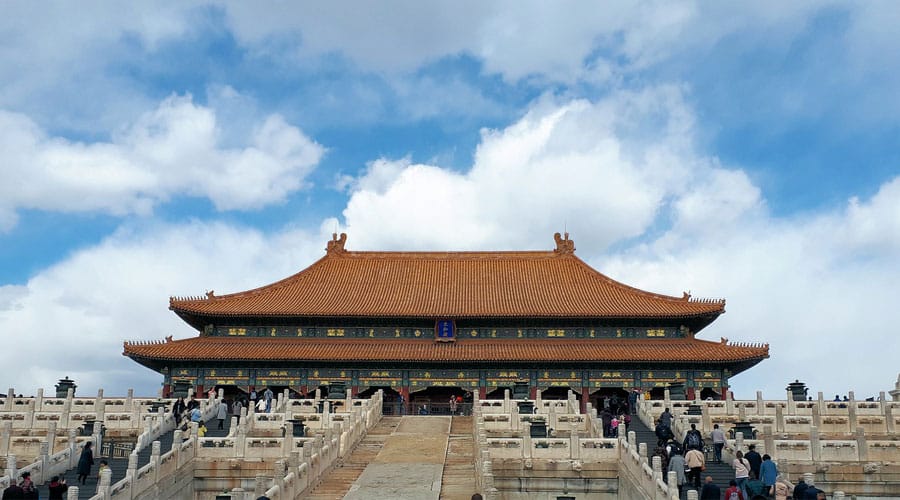In the center of Beijing, You can find the Forbidden City, which is considered the palatial heart of the People’s Republic of China. Also known as the Palace Museum and Gu Gong in Chinese, the Forbidden City once functioned as the imperial palace of the 24 emperors in the Ming and Qing Dynasties (1368-1911). The palace was initially built during the supremacy of Emperor Chengzi of the Ming Dynasty (1368-1644) and the construction took 14 years to complete.
The early Chinese astronomers thought that the Polaris or Purple Star was in the core of heaven and the Heavenly Emperor chose the Purple Palace as His home. That’s why the emperor’s palace here on earth was known as the Purple Palace. Entering the palace is forbidden if special permission from the emperor is not secured. Therefore, it was called “The Purple Forbidden City” or “The Forbidden City”.
Nowadays, it is commonly called the Palace Museum. It is located to the north of another famous tourist spot in Beijing, Tiananmen Square. The palace’s shape is rectangular and covers a total of 74 hectares making it the largest palace complex in the world. Its surrounding has a 52-meter-wide moat and a 10-meter-high wall.
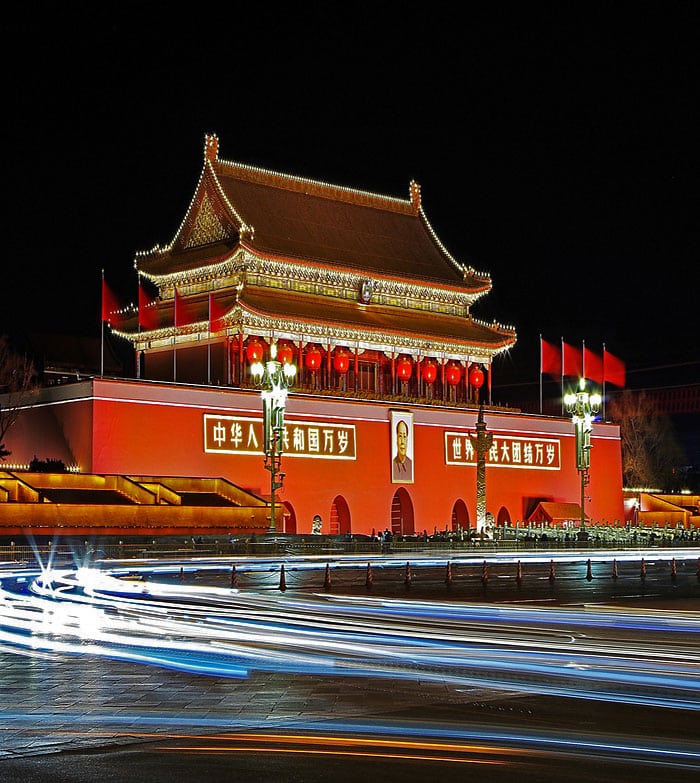
There are 8,700 rooms inside the palace and its wall has a gate on every side. The gate in the south is called the Meridian or Wumen Gate while the gate in the north is named Gate of Divine Prowess or Shenwumen. The distance between the two gates is 961 meters or 1,051 yards. On the other hand, the distance between the east and west gates measures 753 meters or 823 yards. On each of the four corners of the palace’s wall, there are distinctive and skillfully structured towers that were used to have a good view of the whole palace as well as the city outside.
Emperor Yongle of the Ming Dynasty decided to build a royal palace in Beijing in 1406. The palace was designed with the Nanjing Palace in mind. After 14 years, the construction of the grand palace was completed. It was used as the political center of the country for more than 500 years until the Qing Dynasty was defeated in 1911. The Forbidden City was then converted into the Palace Museum in 1925. It houses various traditional Chinese architecture, rare treasures, and ancient remnants.
Construction – 1406 to 1420
When the Ming Emperor Yongle ascended to the throne, he announced that the capital city of China will be moved from Nanjing to Beijing. He also declared the construction of an imperial palace in the center of Beijing and called it the Forbidden City. It was the great architect Kuai Xiang who designed the palace. There were millions of laborers and more than 230 thousand artisans who took part in the construction of the palace. When the royal palace was completed in 1420, Emperor Yongle and his family moved in. Thirteen of Emperor Yongle’s successors also worked and lived in the Forbidden City together with their imperial families.
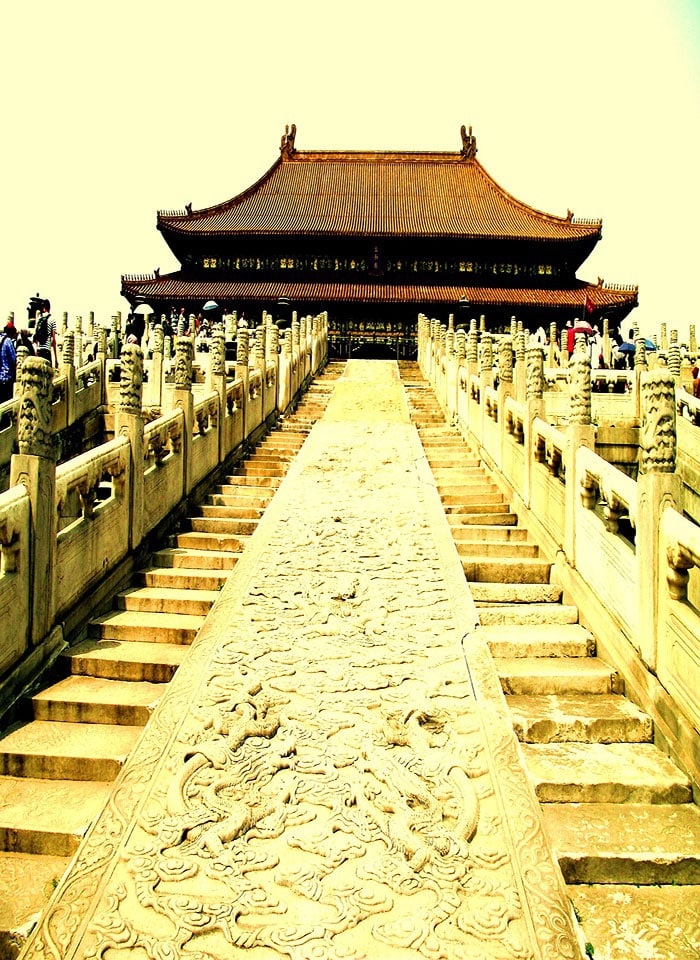
Qing Dynasty Takeover
There were numerous peasant uprisings in China during the last years of the Ming Dynasty reign. The most powerful and widest peasant uprising was led by Li Zicheng. The rebels were able to successfully defeat the imperial troops and enter the Forbidden City. The Ming Dynasty then ended in the year 1644 when Emperor Chongzen committed suicide. But the army of Li Zicheng was soon defeated by Regent Dorgon and his troops. The latter seized the Forbidden City and from then on, the ten emperors of the Qing Dynasty exercised their ultimate power from the Forbidden City.
Destruction and Renovation
Before retreating, Li Zicheng and his troops burned down many of the palaces and halls inside the Forbidden City. When the Qing Dynasty Emperor Shunzhi moved to the imperial city, he spent another 14 years renovating the main buildings along the central axis of the palace. Other destroyed buildings were restored from the year 1683 to the year 1695. The most essential renovation wherein alterations and enlargements were made was during the reign of Emperor Qianlong. The restoration started in 1735 and was completed in 1796. It has returned the Forbidden City to its previous scale and beauty.
Transformed to a Palace Museum for the Public
When the Qing Dynasty was defeated in 1911 after three centuries of ruling the country, Emperor Puyi resigned and the Forbidden City ceased to function as China’s political center. However, the emperor was permitted to stay and live in the Forbidden City until 1924. In the year 1925, the Forbidden City was converted into a Palace Museum and opened to the general public. Since then, the mystery of the royal city was revealed gradually and became known to the common people.
Cultural Relics Removal during War
When the Sino-Japanese War started, millions of rare treasures and cultural relics were packed and put into more than 15 thousand boxes. They were then transported to Shanghai making them safe from being destroyed because of the war. They were later transported to Nanjing and then to the Sichuan province. The treasures were stored in 3 various locations until 1945 which marked the end of the war.
In the year 1947, the remnants and treasures were transported again to Nanjing. Three thousand boxes of the rare treasures were then transported to Taiwan during the Civil War (1945-1949) and were stored in the Taipei Palace Museum. It was in 1951 when more than 10 thousand boxes were brought back to the Palace Museum in Beijing while the remaining boxes were kept in the Nanjing Museum. Finally, after several journeys and wars, the national treasures were brought home to the Forbidden City and the Palace Museum was re-opened to everyone.
Latest Protection and Restoration
The Palace Museum was announced as a key national historical and cultural relic under the protection of the state in 1961 and 1987. Besides, it’s listed as a World Cultural Heritage Site. The museum has not undergone any repair or restoration for many years making some of its palaces and halls weary and collapse. A wide-scale renovation was started in 2002 and is expected to be finished by 2021.
A World Renowned Historical Heritage Site
The Forbidden City was included in the UNESCO World Heritage List in 1987. It is also one of the five top buildings in the world, the other four are Britain’s Buckingham Palace, France’s Versailles Palace, Russia’s Kremlin Palace, and America’s White House.
With a total of around 15 million visitors annually, the Forbidden City is one of the most visited museums in the world. It is also one of the museums, which offer the greatest variety of exhibitions worldwide. You can find nearly 1 million cultural remnants in the palace such as calligraphy, paintings, embroidery, jade, pottery lacquer wares, and many more.
As mentioned, it is the biggest and best-preserved palace complex in the whole world, even the living stations inside are preserved well.
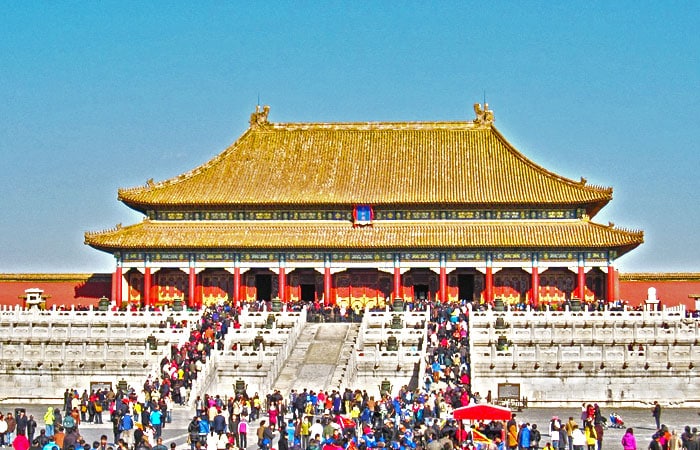
Inner and Outer Courts
Since the Forbidden City is allocated into an Inner Court and Outer Court, the architectural design of each court is entirely different. The solemn public ceremonies of the emperors are held in the Outer Court and that’s why the buildings here are designed to look solemn and grand. In the inside court, on the other hand, is where the emperors spend their domestic and mundane tasks. The architectural designs are less formal and it has courtyards as well as gardens. Besides the halls and palaces alongside the core axis, there are also buildings on each side to house lesser personalities.
Room Counts
There was a myth that the total number of rooms in the Forbidden City is 9,999.5 in total. There was a half room since only the God of Heaven could have a total of 10,000 rooms. It was said that since Emperor Chengzu who built the Forbidden City professed himself as the son of the God of Heaven, asked to have a half room constructed. But in ancient Chinese architecture, one room is composed of a square space with four pillars in a hall. Thus, it was not possible to build a half room with four pillars. The latest count of the rooms is at 8,707, including all the small and big palaces, towers, halls, belvederes, and pavilions.
Color Schemes
The most noticeable colors inside the Forbidden City are red, painted on the walls, windows, pillars, and doors as well as yellow, schemed on the roof tiles. The color red signifies fortunate events, celebrations, and happiness. This is very popular in the daily usage of Chinese. On the other hand, the color yellow represents the earth’s elements at the center. The emperor believes that the imperial palace is located at the center of the world and his sovereignty radiates out from it. Thus, yellow symbolizes the emperor’s royal dictum.
Forbidden Trees in the Outer Court
The three halls in the Outer Court namely, the Hall of Supreme Harmony, the Hall of Central Harmony, and the Hall of Preserved Harmony, are the main structures where important events and rites are held. Planting trees around these halls is forbidden to demonstrate imperial dignity and supreme authority. It was even forbidden to plant trees along the royal pavement from the Tiananmen Gate up to the Meridian Gate. The trees that we see today were only planted in the recent era.
Nine Rows of Door Nails
Once you visit the Forbidden City, take a closer look at the gates inside the imperial city, specifically the big red gates of the main structures, which were designed with glided door-nails. If you look carefully, you will discover that many of the gates have 9 rows of door nails and every row has also 9 nails. The reason is that nine represents supremacy in monarchist China and it is reserved for the use of the emperor.
Paintings and Calligraphy located in the Literary Glory Hall
Some of the most notable ones are the Transcribing a Eulogy by Zhao Mengfu in Regular Script and the Emperor Taizong Receiving the Tibetan Envoy of the Song Dynasty.
Ceramics located in the Martial Valor Hall
Among the intricately designed ceramics in the hall, the Black-glazed Vase Carved with Ripple Patterns, and the Tricolor Pottery Figurine of a Camel in the Tang Dynasty are notable.
Silver and Gold Wares in the Great Balance Palace
The most popular wares in the palace are the Gold Tea Bowl with Characters for Longevity and Happiness (Jinzan tuanshou xizi chawan) and the Gold Pagoda For Containing Hair (Jin fatan).
Jade Articles in the Accumulated Purity Palace
The collection includes the Red Sandalwood Three-panel Ruyi Scepter with Jade Inlays of the Qing Dynasty and the Great Jade Dragon of Hongshan Culture of the Neolithic Age more than 5000 years ago.
The Palace Museum is not only famous because of its palaces and many locals and tourists also admire the Forbidden City’s architectural style. It culminates in classical Chinese and East Asian architecture and influences development as well as Chinese architecture development.
Axially Symmetrical Outline
The Forbidden City was symmetrically constructed along a central north-to-south axis. It is the same axis of the old Beijing City. The three halls in the Outer Court namely, the Hall of Central Harmony, the Hall of Supreme Harmony, and the Hall of Preserving Harmony as well as the Palace of Heavenly Purity, the Palace of Earthly Tranquility, and the Hall of Union of the Inner Court were all built on the central axis. The rest of the palaces were also built in parallel with the core axis.
Each of the palaces is built based on the Chinese traditional Confucian culture and the Book of Changes.
In Confucianism, the supreme status is held by the emperor. Since the emperors believed that they governed the whole country, they decided to construct the imperial city in the center of the capital and their house in the heart of the imperial city. This shows the top status of the emperors. In Chinese traditional culture, the belief is that the left side signifies high ranking or promotion while the right side signifies low ranking or demotion. That’s why the Imperial Ancestral Temple was built on the left and the Altar of Earth and Harvest was constructed on the right. To some degree, the Imperial Ancestral Temple ranks better than the Altar of Earth and Harvest.
On the other hand, the main idea in the Book of Changes is “The union of human beings and nature”. The union of heaven and earth is reflected in the Palace of Heavenly Purity and the Palace of Earth Tranquility. With the hope of harmonizing the imperial city with nature, the gates were built based on the Chinese Eight Diagrams. All the palaces were built along the core axis symmetrically because the ancient Chinese people strongly believed in balance and harmony.
The Palace’s Decorations and Structure
The major frames of every palace in the imperial city are constructed with wood. The most essential elements are the wooden beams and columns while the walls serve as auxiliary structures.
In building an ancient Chinese edifice, color painting is used to decorate as well as protect the wooden base from deteriorating. The themes of the color painting are phoenixes and dragons. The categories applied to the color painting are Suzhou-style pattern paintings, tangent circle pattern paintings, and imperial pattern paintings.
The Suzhou-style patterns were applied to towers, pavilions, and in gardens. Tangent circle patterns included gyrating decorative patterns that were applied to the sidewalls, subordinate halls, and side halls. The superior patterns used are the imperial patterns of dragons and phoenixes. Such was applied to the core axis and other main palaces. Dragon patterns were applied to represent the emperors and a total of 12,654 dragons were painted in various styles. Phoenixes, on the other hand, were used to represent the empresses.
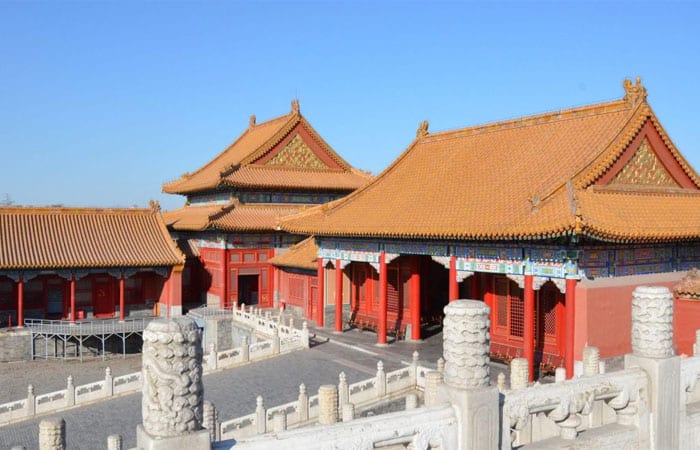
Roofs and Eaves Decorations
The roof designs are attractive too. There are more than ten different kinds of roofs that exist inside the imperial city and the Outer Court’s three halls also have different roofs. The ten different roofs inside the city are mostly single-eave hip roofs, pyramidal-hipped roofs, and hipped-gable roofs.
The highest level of the roof belongs to the Hall of Supreme Harmony. It has ten mythical animals in every corner of the roof which signifies superiority. The mythical animals represent special purposes and characteristics in Chinese architecture.
The animals on the ancient buildings’ ridge include Chiwen, the kissing dragon, the lion, the Phoenix, Suanni – the lion-like dragon, the heavenly horse, as well as the seahorse, Haetae, Yayu – the fish dragon, Douniu – the bull-like fighting dragon, and the flying monkey – Xingshi. The ancient Chinese believed that the kissing dragon is one of the nine sons of the dragon who watches fire, the Phoenix is said to bring good luck and happiness to the palace, the lion symbolizes power, the horses represent the ability to reach the heavens and the seas, Suanni, another son of the dragon is the animal kingdom’s king, Yayu can collect clouds and stop the fire, Haetae which is a unicorn symbolizes justice, Douniu signifies peace, and the flying monkey is for the prevention of destruction caused by thunder.
The number of animals on the ridge of the roof also signifies the rank of the owner and the building. The emperor used the Hall of Supremacy Harmony, which has the highest level of the building and the ten mythical animals on its ridge. The other two halls have lower-status roofs.
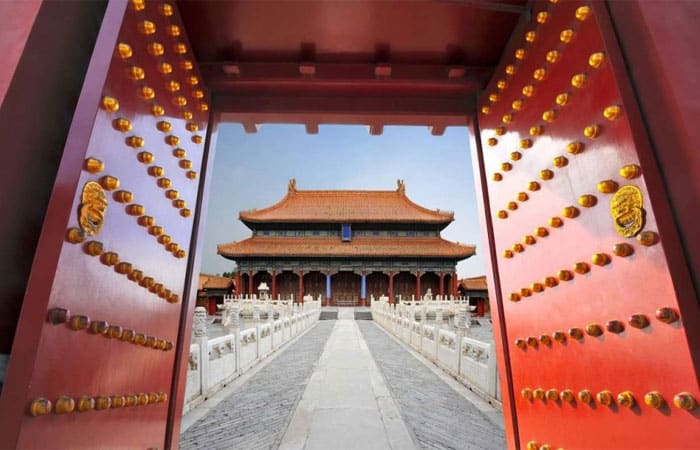
The Palaces’ Terraces
The terraces under the palaces are designed exquisitely and are used to support the palaces and evade getting septic. The decorations and the height of the terraces are strongly limited by the hierarchy system. The Outer Court’s three halls have the most beautiful and intricate terraces. They have three-layered terraces with 8 meters in height. The stone lion heads built around the terraces are used as decorations and drain systems as well.
The museum’s itinerary is a unidirectional south-to-north route. Its visitors can only enter using the Meridian Gate and go out of the museum using either the Gate of Divine Prowess or East Prosperity Gate. To tour the central axis, you will need three to four hours. But if you are interested in wandering and exploring the imperial palace, more time is needed.
How to get to?
| By Subway | |
|---|---|
| Line 1 | You can take Subway Line 1 and get off either at Tiananmen East Station or West Station. Find the Tiananmen Tower and walk to the north to get to the Meridian Gate. |
| Line 2 | You can take Subway Line 2 and exit at Qianmen Station where you can also walk north passing the Tiananmen Tower to the Meridian Gate. |
| By Bus | |
| Tiananmen East Station | While the busses that will take you to Tiananmen West Station are the bus 1, 5, 52, Sightseeing Bus Line 1, Line 2, and Tourist Line 2. |
| Tiananmen West Station | While the busses that will take you to Tiananmen West Station are bus 1, 5, 52, Sightseeing Bus Line 1, Line 2, and Tourist Line 2. |
Ticket price & Opening Hours
| Prices | |
|---|---|
| Entrance (April to October) | 60 Yuan |
| Entrance (November to March) | 40 Yuan |
| Treasure Gallery | 10 Yuan |
| Clock and Watch Gallery | 10 Yuan |
| Opening Hours | |
| April to October | Operating hours are from 8:30 am to 5:00 pm, ticketing time is from 8:30 am to 4:00 pm, and entry time is from 8:30 am to 4:10 pm. |
| November to March | Operating hours are from 8:30 am to 4:30 pm, ticketing time is from 8:30 am to 3:30 pm, and entry time is from 8:30 am to 3:40 pm. |
| Closed Days | The Forbidden City is closed every Monday except on Chinese statutory holidays. |
Note:
- The entrance fee for children under 3.9 feet is free but they need to be accompanied by an adult.
- The admission tickets for minors aged 6 to 18 are CNY 20 and their admission fee in Treasure Gallery and Clock and Watch Gallery is CNY 5 each.
- The elders aged 60 and above can get a 50% discount upon showing a valid ID or passport.
- The annual ticket which costs CNY 300 good for 10 entries for the year is only offered to Chinese citizens.
The museum visitor capacity per day is 80,000. Every visitor must purchase a ticket online or scan the official QR code on-site. The official booking website is not yet offering its services in English, so foreign visitors need to purchase their tickets through their Chinese friends or travel agencies. There is also a ticketing window near the Meridian Gate should you want to try walking in.
The museum is imposing a real-name policy before entering the museum. ID cards of the Chinese visitors should be swiped at the entrance while foreign tourists must first go to a special lane to have their passports verified. Do you have any more information to add? feel free to share your experiences and comments with us. Besides, if you are going to visit Beijing and you need more detailed information, leave your questions and our professional guides will reply as soon as possible.

